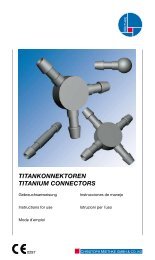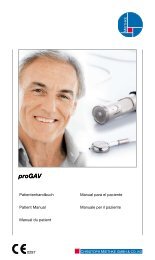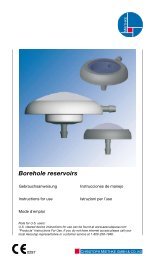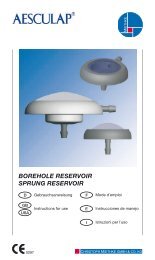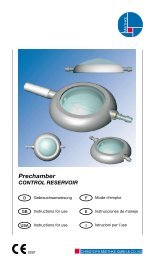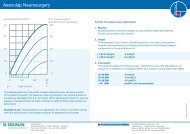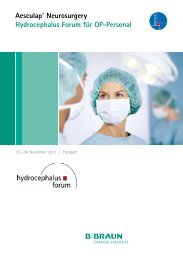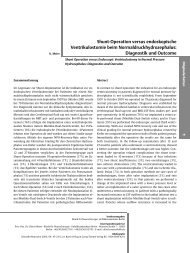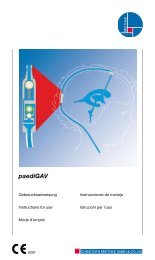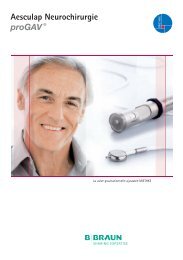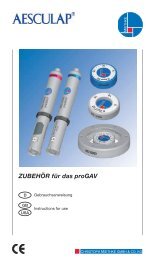miniNAV - Christoph Miethke GmbH & Co. KG
miniNAV - Christoph Miethke GmbH & Co. KG
miniNAV - Christoph Miethke GmbH & Co. KG
You also want an ePaper? Increase the reach of your titles
YUMPU automatically turns print PDFs into web optimized ePapers that Google loves.
22<br />
GB USA<br />
Pressure-flow characteristics<br />
Pressure rating<br />
cmH2O<br />
<strong>miniNAV</strong><br />
Acceptable<br />
pressure<br />
ranges<br />
0 0-5 cmH2O<br />
5 2-9 cmH2O<br />
10 7-15 cmH2O<br />
15 12-20 cmH2O<br />
The diagrams below show the pressure-flow characteristics for the pressure ratings in<br />
which the <strong>miniNAV</strong> is available.<br />
Pressure ( cmH2O)<br />
Pressure ( cmH2O)<br />
20<br />
15<br />
10<br />
5<br />
20<br />
15<br />
10<br />
0 5 10 15 20 2530<br />
35 40 45 50 55<br />
5<br />
<strong>miniNAV</strong> 0 cmH2O<br />
Pressure rating 0 cmH2O<br />
Flow (ml/h)<br />
<strong>miniNAV</strong> 10 cmH2O<br />
Pressure rating 10 cmH2O<br />
0 5 10 15 20 2530<br />
35 40 45 50 55<br />
Flow (ml/h)<br />
Pressure ( cmH2O)<br />
Pressure ( cmH2O)<br />
20<br />
15<br />
10<br />
5<br />
20<br />
15<br />
10<br />
<strong>miniNAV</strong> 5 cmH2O<br />
0 5 10 15 20 2530<br />
35 40 45 50 55<br />
5<br />
Pressure rating 5 cmH2O<br />
Flow (ml/h)<br />
<strong>miniNAV</strong> 15 cmH2O<br />
Pressure rating 15 cmH2O<br />
0 5 10 15 20 2530<br />
35 40 45 50 55<br />
Flow (ml/h)<br />
The total opening pressure refers to a reference flow of 5 ml/h. When the flowrates reach 20 ml/h,<br />
the opening pressures are approximately 1-2 cmH2O higher.<br />
<strong>miniNAV</strong> USA<br />
Test on reflow safety<br />
This test is carried out with the same<br />
equipment as the pre-implantation test.<br />
The shunt is carefully filled with sterile saline<br />
solution from the syringe before the<br />
air is removed from it (Fig. 11). The shunt<br />
is connected against the direction of flow<br />
(see arrow on the shunt). The outlet of the<br />
shunt has to be at the zero level of the manometer.<br />
The manometer is filled up to 14<br />
cmH2O (Fig. 12).<br />
The three-way faucet is used for unblocking<br />
the flow to the shunt and blocking<br />
the flow to syringe. In this setup, no more<br />
than 2 drops (0.1 cc) per minute should<br />
emerge from the proximal part of the<br />
shunt (Fig. 13).<br />
Caution: Be careful to maintain sterility<br />
and to avoid particle contamination.<br />
isotonic sterile sodium chloride solution<br />
Fig. 12<br />
Fig. 13<br />
Fig. 14<br />
0-level<br />
0-level<br />
closed<br />
open<br />
14 cm<br />
open<br />
14 cm<br />
closed<br />
Surgical procedure<br />
GB<br />
positioning the ventricular catheter<br />
Several surgical techniques are available<br />
for positioning the ventricular catheter.<br />
The necessary skin incision should be<br />
carried out, preferably, in the shape of a<br />
lobule pedicled towards the draining catheter<br />
or as a straight skin incision. To<br />
avoid CSF leakage, care should be taken<br />
that the dura opening is kept as small as<br />
possible after applying the borehole. The<br />
ventricular catheter is stiffened by the<br />
introducing stylet supplied with the product.<br />
The <strong>miniNAV</strong> is available in different shunt<br />
variants:<br />
When using a <strong>miniNAV</strong>-SHUNT SySTEm<br />
with borehole reservoir or SpRUNg RE-<br />
SERVOIR, the ventricular catheter is implanted<br />
first. Once the introducing stylet<br />
has been removed, the patency of the<br />
ventricular catheter can be tested by checking<br />
if CSF is dripping out. The catheter<br />
is shortened and the borehole reservoir is<br />
connected, with the connection secured<br />
with a ligature. The skin incision should<br />
not be located directly above the reservoir.<br />
The <strong>miniNAV</strong>-SHUNTSySTEm with<br />
prechamber or CONTROl RESERVOIR<br />
comes with a deflector. This deflector is<br />
used for adjusting the position of deflection<br />
before implantation of the ventricular<br />
catheter. The catheter is deflected; the<br />
prechamber is put into place. The position<br />
of the ventricular catheter should be<br />
inspected again by postoperative CT or<br />
MR imaging.<br />
Warning note:<br />
Frequent pumping can lead to overdrainage<br />
and thus pressure conditions<br />
outside of the normal physiological<br />
range. Patients should discuss<br />
the risks (involved) with their surgeon.<br />
23



